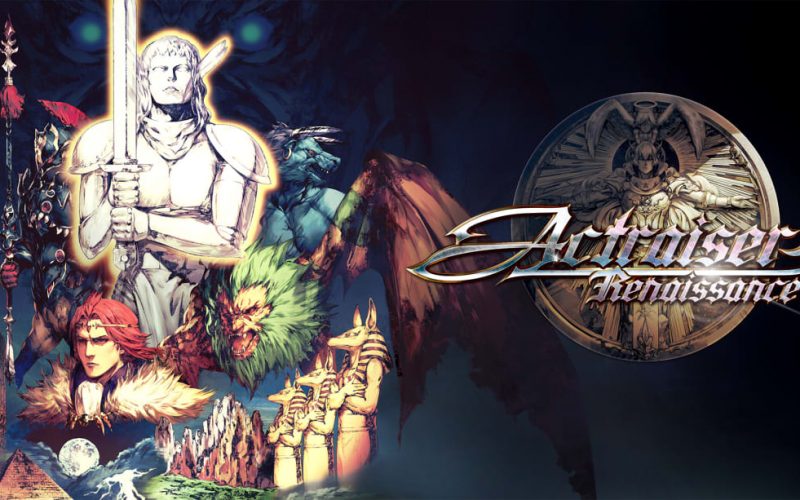One of my preferred ways of playing games is to play until I achieve full completion. This is quite subjective and has changed considerably over the years. When young, I would try to 100% a game and leave a save file that was near the end in case I wanted to replay the ending. As the years passed, games evolved and gave us new ways of tracking the progress. Star Fox 64 gave us a different title screen. Mega Man Battle Network gave us the stars to track completion. Then the Xbox finally gave us achievements, and I settled on using those to track my completion.
After spending so much time on a game to achieve the full completion, you grow a little attached to it. Some times I just look back at how much I played and how much I achieved and just smile. Boss fights that used to be tricky now feel like a breeze. Moments that made me angry are now just an afterthought. But some times the hardest part is saying good bye. This is why I’m deciding to write this prologues, as a fare well to a game that stuck with me for tens of hours.
Old games, new experiences
I’ve had ways of playing emulated games ever since I got my first computer in the late 90’s. While I’ve always preferred gaming on consoles and renting my games, some times emulation has saved me when the gaming world moves on. The one console I like to revisit the most is the SNES, but at the same time, it became harder to do so as time went on and before we got the virtual console. My savior came in the form of a hacked Xbox my uncle gave me and which came preloaded with tons of games.
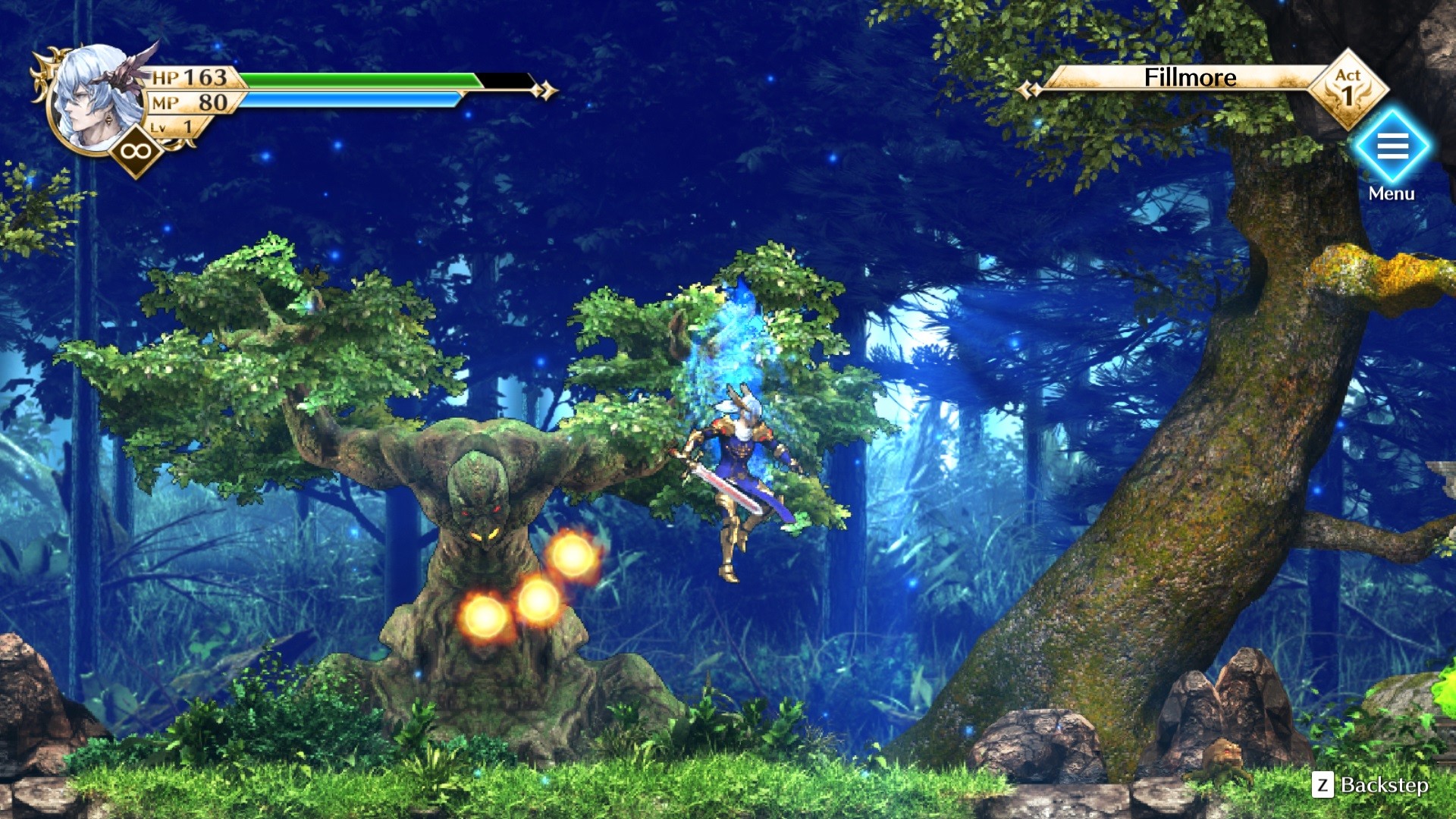
Scrolling through lists of roms is something I’m quite familiar with, but alphabet sorting favors some letters more than others. As I scrolled through the list I spotted a familiar title: Actraiser. I remembered this game, after all, I’ve rented it before at blockbuster. The demo reel that plays when you’re idle at the title screen is burnt into my memory. A sort of angel with sword and shield in hand descending on some godly stage and fighting a demonic enemy. I booted up the game with the intention of playing it again.
My first meeting with the Lord of light
Except that this game looked nothing like what I remembered. I was tossed into a stage with an unfamiliar protagonist, and without wings, but I decided to play anyway. I quickly discovered the game from my memories was the sequel, so I thought it would be fun to experience the first entry in the series.
After defeating the boss, I was tossed into this sim city view and asked to help the town of Fillmore to develop. This was nothing like the Actraiser I remembered and I had no interest in playing a sim builder game. But I didn’t have anything better to do that day, so I just kept playing to see where it goes. Eventually, I started to appreciate the relaxing pace of town building, as opposed to constant fighting. I started to appreciate this change between action and town sim, especially because of the deeper meaning of descending into action as the Lord of Light.
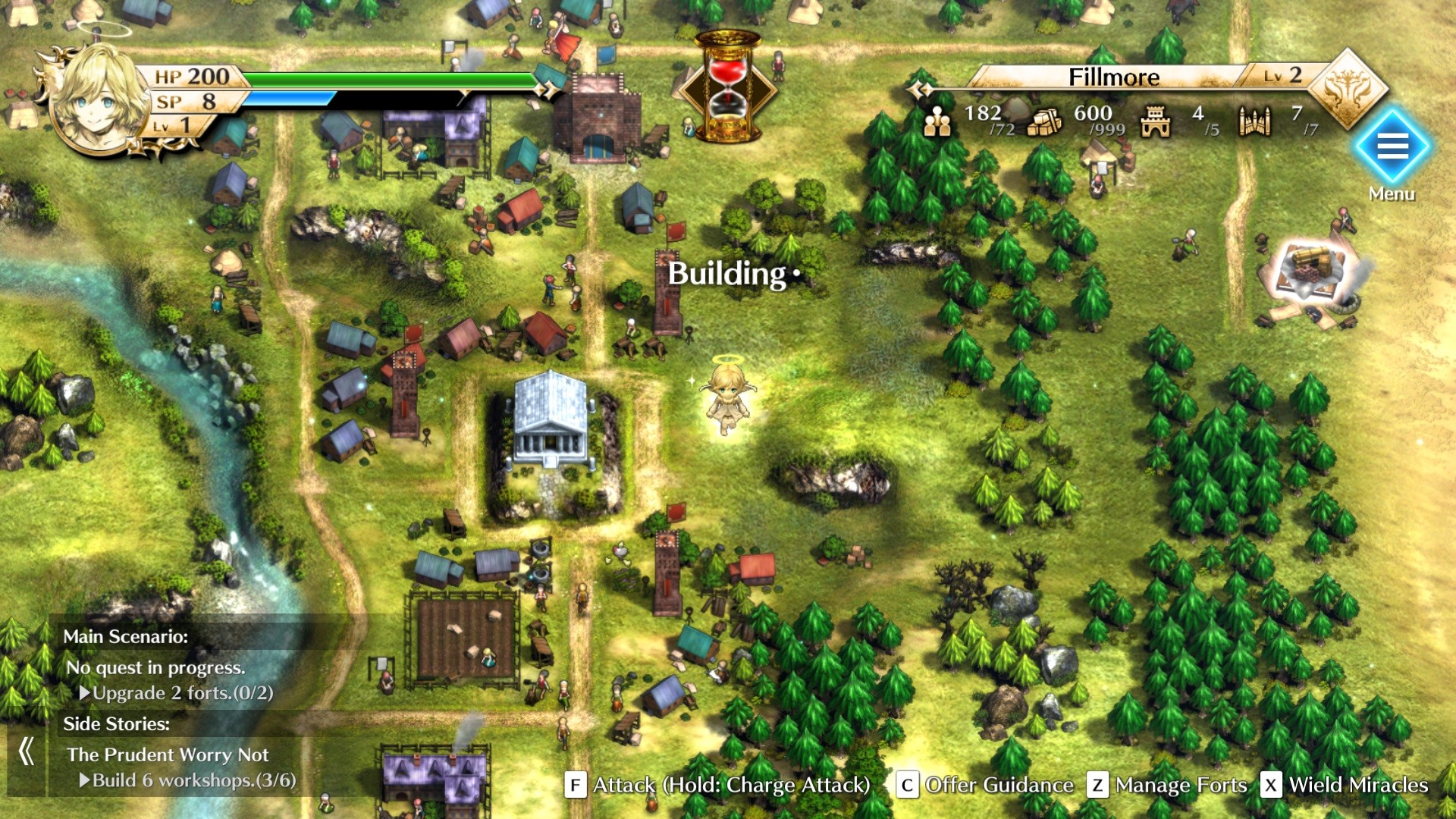
These were my people and I’d go down and smite the forces of evil for their sake!
A classic reborn
Seemingly out of nowhere, a remake of the original game was announced during a Nintendo Direct presentation. I’m sure many people were focused on other news, but Actraiser definitely took the spotlight for me. After all, it brought back a game I really enjoyed and that very few people seemed to remember. A true renaissance after all.
This remake completely redoes the game in terms of graphics, soundtrack and even gameplay. Perhaps what caused a wrong impression with players was the graphical aspect more than anything. There’s many ways of making a 2D game in the modern era, so what Actraiser Renaissance went with, isn’t what most people expected. It had a style that I can only describe as 3D models being photographed on 2D, with low-res background that might have come from a mobile game.
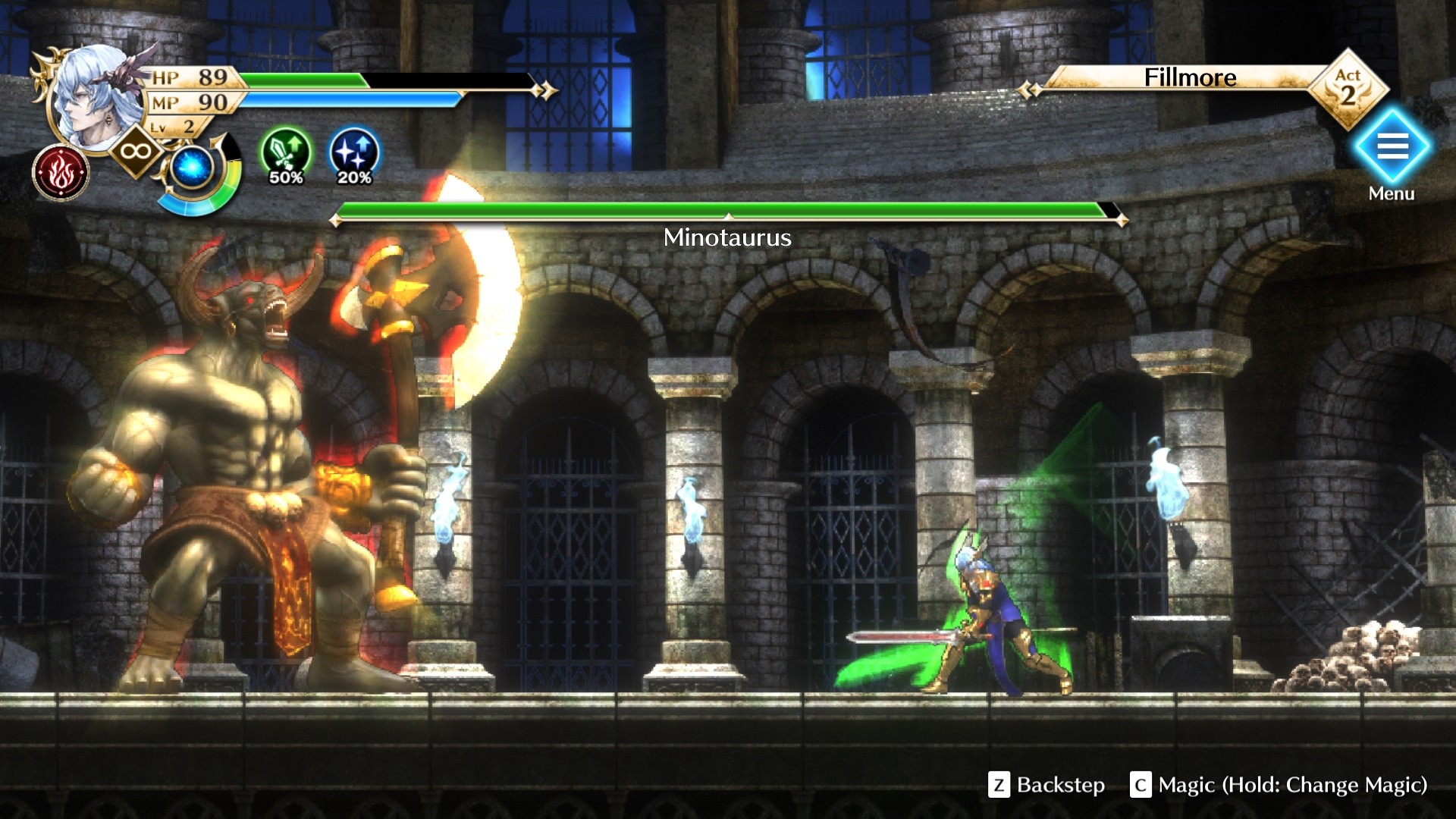
I’ll count myself as one of those who wasn’t enticed by the graphics when I first saw the trailer. However, during my 40 hours or so of gameplay it kind of grew on me. What really brought it all up is the design of the interface. The interface looks extremely clean and polished. The gameplay effects also help put it all together by adding particles and even cool effects such as when collecting crystals.
Newer combat
ActRaiser was never known to have deep combo systems, and renaissance won’t be the exception. From the early SNES days, if was just about jumping and slashing your way through the levels. It still stays mostly the same, but there are new combo routes and additional input attacks.
In my opinion, the combat in Renaissance boils down to abusing your invincibility and stun-locking the enemies. For the latter, you quickly learn that while you are doing your combo on an enemy, that enemy will stop attack and continue to take your hits until it dies. This changes the dynamic to trying to approach enemies from a safe location and getting the first hit in. After the first hit, you’re golden!
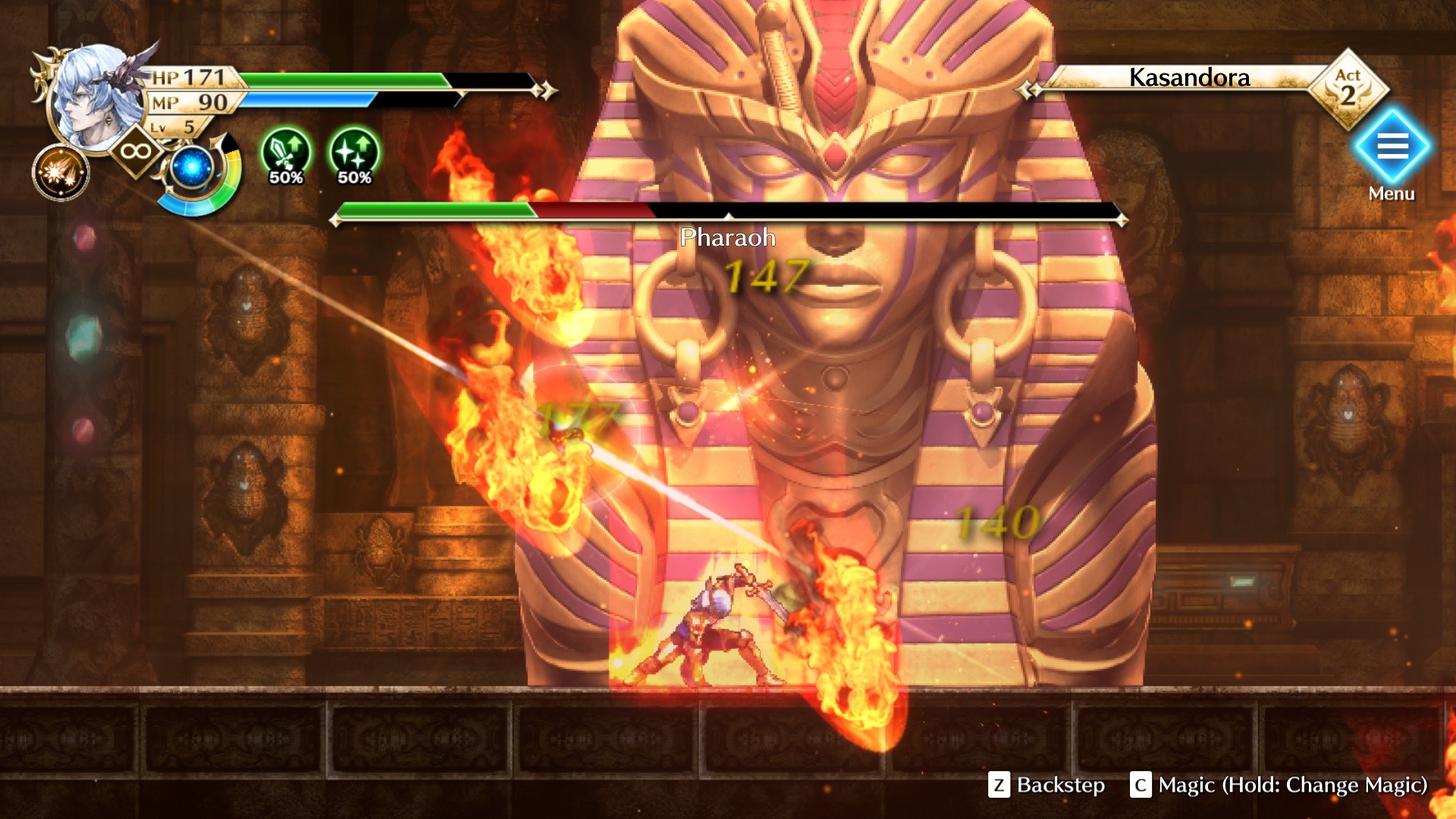
For the invincibility, there are 2 main “defensive” moves: the up slash and backdash. The backdash will move you back quickly while being invincible. You can totally go through enemies without taking damage. The up slash is meant to be used to attack high enemies, but it comes with a good deal of invincibility. What’s cool is that you can cancel any attack into an up slash, so you can be hitting an enemy and transition into an invincible up slash if there is incoming danger from another angle. It’s even better for some mini-bosses and bosses that don’t flinch, so you can keep attacking them and cancel into defense at any point.
The power of the crystals
A new element that was added to Renaissance is the crystal buff. As you go through levels and defeat enemies, you will pick up crystals that will fill up your gauge. Once it reaches certain points, either your attack of magic power will increase to +20%, then +50% and finally +100%. Filling the bar also gives you a one-time resurrection when your HP goes to 0.
As a concept, I really dig what the implications of the crystals are during the levels. They make each stage as a mini RPG where exploration and combat are rewarded by increases in damage. Even better that powering up will give you a cool afterimage effect when you move. A nice way to put this is that the crystals are akin to the coins in Mario games. They aren’t mandatory, but if you pay attention you discover the coins lure you into places of interest during any level, like breadcrumbs. The same goes for ActRaiser Renaissance.
The small caveat, is that it punishes speed runs. I don’t mean record runs where you go for a world record, but rather just trying to beat a stage fast because you missed a collectible. If you try to play the game on special mode and pick the divine difficulty, you will discover that it might as well be mandatory. Enemies have so much HP that anything less than +50% is basically wasting your time. However, these issues were only present to me on the final stretches of my Divine playthrough. I think Divine as a whole is badly designed as a difficulty, but more on that later.
The town sim
If there is one aspect of the game that I’m really torn about, it’s definitely the town sim portions of the game. It’s been a while since I played the original SNES game, but I remember this portion being a chill experience where I could watch my people grow their towns with minor intervention from my side. Renaissance opted to add new mechanics and storylines to make this segments more “interactive”. I really dislike this, as I don’t think a game has to make players push buttons all the time. I enjoyed the passive nature of the towns, so the new town sims feel like the worst of two worlds with the inherent helplessness from having the townsfolk do pretty much whatever they want and the need for attention that the remake imposes.
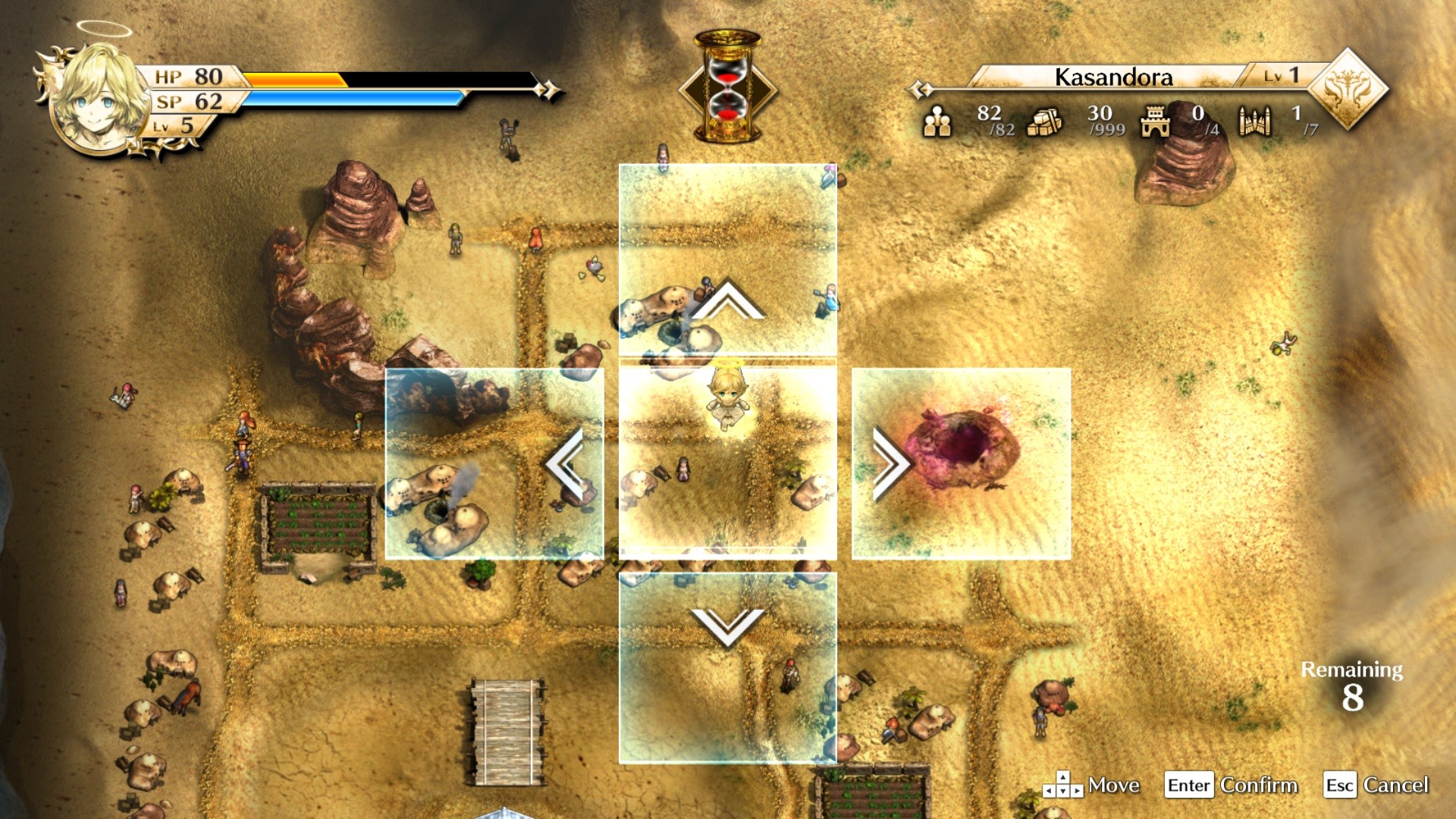
The new additions to this mode are: the town defenses, the town storylines and the hero storylines.
The town storylines felt pretty good to me. It humanized the people and actually made me feel more involved with their mishaps when trying to create a prosperous civilization. Although the constant events became a bit annoying because you couldn’t sit back and lead them to build something without being hit with a new event every 10 seconds. An interesting addition with some annoying interference.
The hero’s journey
The hero stories are new plots that give you a hero per village that goes through its own journey of personal growth and faith onto the Lord of light. It isn’t much too different from how the town tells its own stories. Overall I think the heroes were good additions that might take away a little of the identity of a thriving town, but which I enjoyed nonetheless.
However, it did feel al little weird that at times the heroes were revered more than the Lord of Light. I feel that undermines the concept of having the people’s faith in the Lord of Light grow, when sometimes they seem to value the heroes more.
Now the tower defense portions were the thing that I absolutely hated the most. I’m not big on tower defense games, because I don’t feel as in control as with action games. The tower defense, or sieges, are quests where monsters gather to attack the village and must be defended by placing towers and directing the heroes. As the game progresses, sieges become trickier and different types of enemies appear to make sure your defense is varied. Fliers, magic inmune, glass cannons, all contribute to making sieges more challenging.
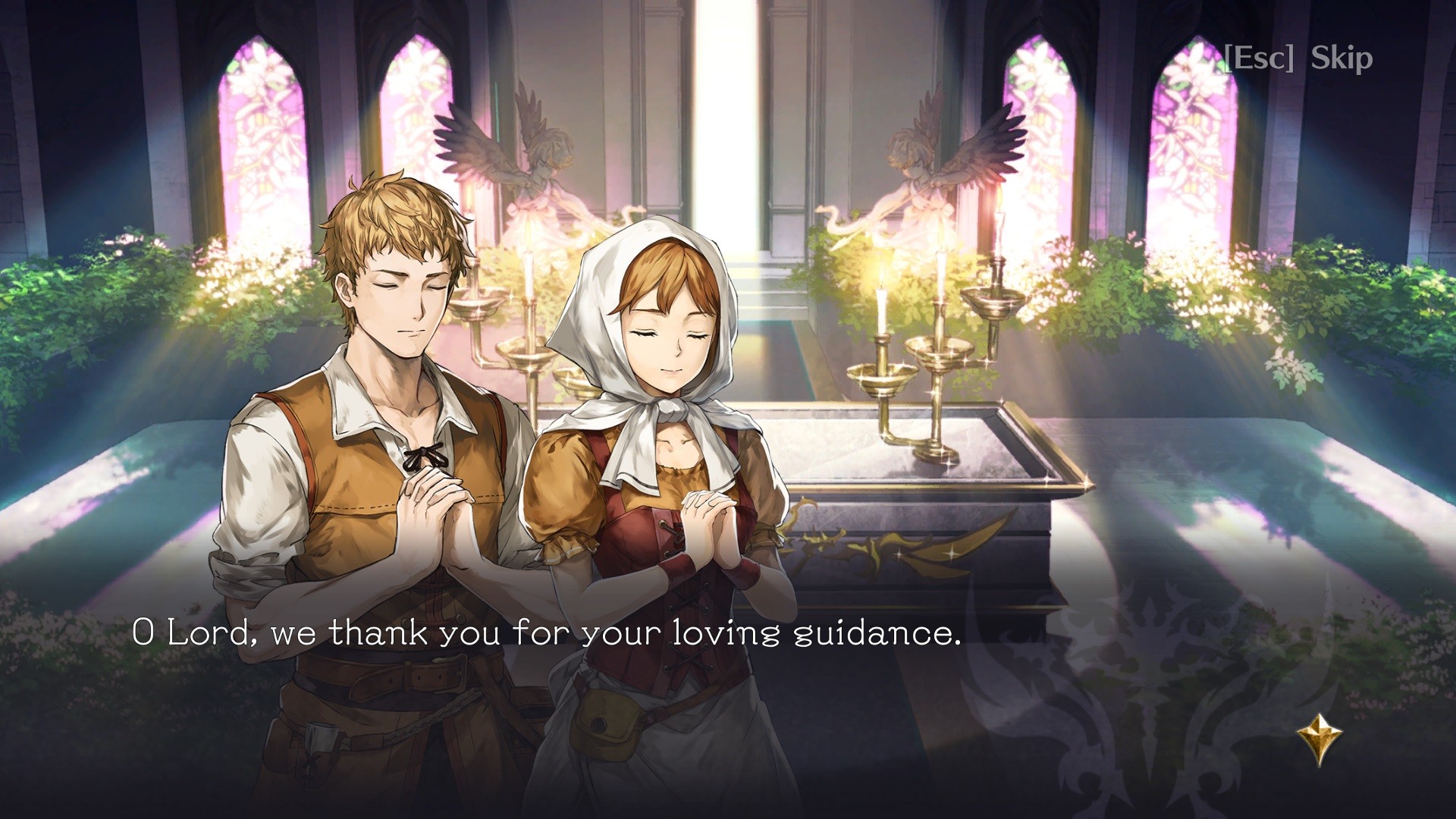
the cracks at the rampart
My issue is that these sieges are pretty static once the battle begins. Other than throwing miracles or moving your heroes, there isn’t much you can do as opposed to tower defense games. You can’t move your forts or gatehouses during a siege. So you could face a siege where magic immune enemies attacked where your magehouses where, while fliers ran past your forts. If you play on harder difficulties like me, you are almost guaranteed to lose a siege the first time around because you don’t know how you will be attacked and you can’t adapt on the spot.
So between having to repeat sieges because you can’t possibly be prepared, and farming resources to upgrade your building before sieges, I found both to be a huge waste of time. In the end, I just started forming clusters with my forts closer to the temple to maximize damage. It ended up with me surviving most sieges while 70% of my towns were razed to the ground, but at least no replay was needed. It still felt terrible. I wasn’t really defending my town, just cheesing it because it can’t be properly defended unless you know what’s coming.
So, to recap, I hated sieges. They don’t play like proper tower defense games. All they do is introduce a completely unnecessary mini-game because they believe gamers want more interaction in their town sims.
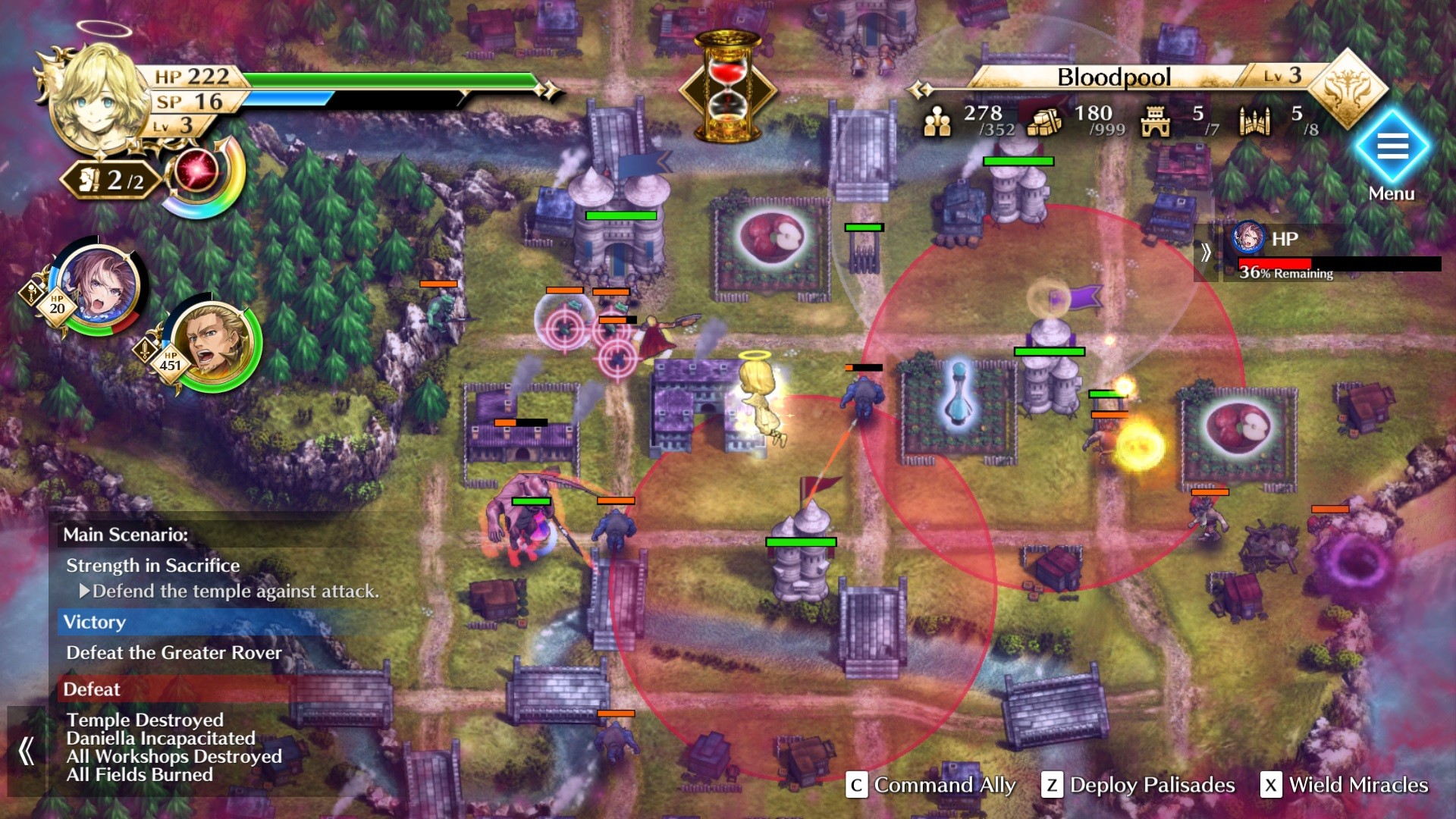
The road to platinum
While I enjoyed the main story for the most part, even with the town sieges, the completion achievements were not what I expected. Rather than expanding on the game or presenting new challenges, they felt grindy and tedious. They also made me do countless sieges.
The biggest culprit was to level up the heroes to level 20. At the end of the game, most heroes are barely halfway there at lvl 10. So how do you level them up? By defending your towns and acquiring chronicles. So to level up my 6 heroes to max level, I had to defend their towns… A LOT. A proper defense gives you 10 chronicles, and you require around 20 chronicles to level up after 10. So that’s at least 20 raids to complete, but raids don’t just happen on command, they occur at random. I timed their appearance, and it seems one would pop up every 3 minutes.
So since I had to do 20, that totals more than an hour of waiting to level up a hero to max, plus the time taken during the raids. That’s per hero, so I had to do at least 6 rounds of those. In the end, I just watched TV while waiting for raids to appear and do repairs in-between. This achievement achieves nothing really, it’s just pointless grinding at the end game.
The divine
The other significant achievement was to complete all stages on the special mode while on the Divine difficulty. There’s actually an achievement for completing all stages per each of the 4 difficulties. Luckily, doing a harder difficulty unlocks the lower achievements as well. I also completed the main game on Hard difficulty, so it was only a step ahead.
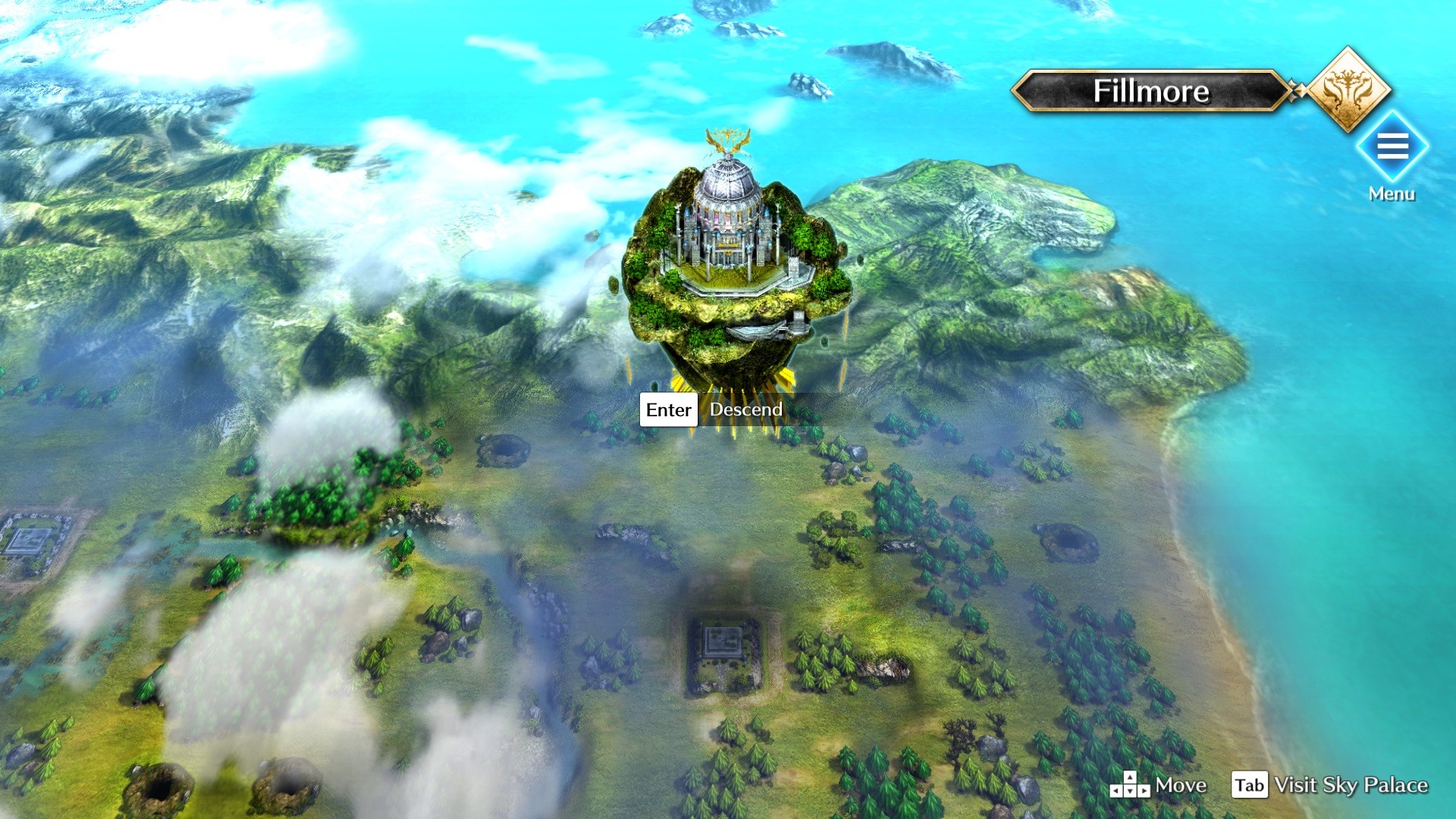
Divine as a difficulty was extremely boring. As a difficulty setting, it felt as it only increased the base stats of the enemies. So enemies had more health and did more damage. So if you remember what I said previously about combat, this change in stats take a turn for the worse. You can still stun-lock enemies, but you have to do so for so much longer that it becomes boring and repetitive. The extra health on the bosses also guarantees that you need +100%, or else the battle will drag for eternity. So now you have to waste your time with small fry that won’t die because you need the crystals to be able to do decent damage to the bosses.
You also had to reach a cumulative 20 million score points for an achievement, but I reached that number just by beating the Divine stages. As long as you don’t die, collect the golden statues and beat the stage, then you should be good.
The missing achievements
With how many additional achievements were sprinkled, I was surprised by the achievements that were missing. First of all there wasn’t one for beating the campaign on the harder difficulties. Although I do understand why that might be, as the game allows you to change difficulty at any point. It’s a nice accessibility feature, although I wish I had known that before so that I could do town sieges on easier difficulties and action stages on hard.
The other missing one was for 100% item collection. Every Act has 3 scrolls that permanently increase your HP and SP. The stages track how many of those you have collected, so I was surprised to learn that my collecting of all the scrolls had no effect other than making me buff.
May your faith in the Lord of Light never waiver
With all that’s being said and done, I really enjoyed ActRaiser Renaissance! It felt great to see an old friend and looking as amazing as this one does! While I didn’t love every aspect of it, the entire experience felt pretty great and this was most definitely a game that I’m glad I played until the end. Perhaps if I had to do it all over again, I wouldn’t go for all achievements and just stop after the post-game. But I already did and I can say I mastered my powers as the Lord of Light.

